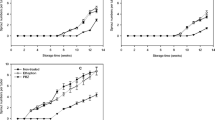Abstract
A five-year storage season study using small-scale bins was undertaken to determine the effectiveness of 2,6-diisopropylnaphthlene (2,6-DIPN) in combination with isopropyl-N-(3-chlorophenyl)carbamate (CIPC) for sprout suppression of stored potatoes (Solanum tuberosum L.). The study environment simulated a commercial operation and the storage bins held up to 4,500 kg of tubers. Russet Burbank potatoes were tested for four storage seasons, and for one season the bin space was split between Ranger Russet and Snowden potatoes. Sprout suppression was measured as percent acceptable for fresh pack (%AFP), defined as sprouts ≤3 mm in length. When 2,6-DIPN was used alone at 8.3 mg kg-1 fw, it only provided short-term sprout suppression. Sprout suppression responses for the two chemicals were similar for Russet Burbank, Snowden and Ranger Russet. When 2,6-DIPN was used in combination with CIPC, a significant increase in sprout suppression was observed. In addition, when the two chemicals were used in combination, the amount of CIPC could be reduced by as much as 50% while still maintaining equal or better sprout suppression as compared to CIPC alone. For overall long-term sprout suppression, the best treatment was a combination of CIPC and 2,6-DIPN, each at 16.6 mg kg-1.
Resumen
Con el objeto de determinar la efectividad del 2,6-diisopropilnaftaleno (2,6-DIPN) en combinación con el isopropil-N-(3 clorofenil) carbamato (CIPC) para la supresión del brotamiento en papa (Solanum tuberosum L.) almacenada, se llevó a cabo un estudio durante cinco periodos de almacenamiento. El estudio se realizó en un ambiente similar al utilizado en operaciones comerciales, en recipientes pequeños con capacidad de hasta 4.500 kg de tubérculos. Se probaron papas Russet Bur-bank por cuatro períodos de almacenamiento. Durante un período se colocaron papas Ranger Russet y Snowdon en el mismo recipiente. La supresión del brotamiento se midió como porcentaje aceptable para empaque en fresco, considerándose como aceptable brotes de 3mm de largo. Cuando se utilizó únicamente 2,6-DIPN a razón de 8.3 mg kg-1 de peso fresco, se produjo sólo una supresión de brotamiento de muy corta duración. Las respuestas de supresión de brotamiento fueron similares para Russet Burbank, Snowden y Ranger Russet. Cuando se utilizó 2,6-DIPN en combinación con CIPC se observó un significativo incremento en la supresión del brotamiento. Adicionalmente, cuando los dos productos quimicos se usaron en combinación, la cantidad de CIPC pudo reducirse hasta en un 50%, manteniéndose una igual o mejor supresión de brotamiento en comparación que cuando se usó solamente CPC. Para una supresión completa, el mejor tratamiento fue una combinación de CIPC y 2,6-DIPN, a razón de 16.6 mg kg-1 cada uno.
Similar content being viewed by others
Abbreviations
- CIPC:
-
Isopropyl-N-(3-chlorophenyl) carbamate
- (2,6-DIPN):
-
2,6-diisopropylnapthalene
- DMN:
-
dimethylnaphthalene
- %AFP:
-
Percent acceptable for fresh pack
- mg kg-1 :
-
mg of active ingredient kg-1 fresh potato
Literature Cited
Beveridge JI, J Dalziel, and HJ Duncan. 1981a. The assessment of some volatile organic compounds as sprout suppressants for ware and seed potatoes. Potato Res 24:61–76.
Beveridge JI, J Dalziel, and HJ Duncan. 1981b. Dimethylnaphthalene as a sprout suppressant for seed and ware potatoes. Potato Res 24:77–88.
Everest-Todd S. 1986. Plant growth regulators. Canadian patent number 1,203,394.
Kalt W, RK Prange, BJ Daniels-Lake, J Walsh, P Dean, and R Coffin. 1999. Alternative compounds for the maintenance of processing quality of stored potatoes (Solanum tuberosum). J Food Proc Pres 23:71–81.
Lewis MD, GE Kleinkopf, and KK Shetty. 1997. Dimethylnaphthalene and diisopropylnaphthalene for potato sprout control in storage: 1. Application methodology and efficacy. Am Potato J 74:183–197.
Riggle BD, and RS Schafer. 1997. Sprout inhibition compositions comprising chlorpropham and substituted naphthalenes and methods of using same. U.S. patent number 5,622,912.
Sparks WC. 1965. Effect of storage temperature on storage losses of Russet Burbank potatoes. Am Potato J 42:241–246.
Vaughn SF, and GF Spencer. 1991. Volatile monoterpenes inhibit potato tuber sprouting. Am Potato J 68:821–831.
Vaughn SF, and GF Spencer. 1993. Naturally-occurring aromatic compounds inhibit potato tuber sprouting. Am Potato J 70:527–533.
Author information
Authors and Affiliations
Corresponding author
Rights and permissions
About this article
Cite this article
Beaver, R.G., Devoy, M.L., Schafer, R. et al. CIPC and 2,6-DIPN sprout suppression of stored potatoes. Am. J. Pot Res 80, 311–316 (2003). https://doi.org/10.1007/BF02854315
Accepted:
Issue Date:
DOI: https://doi.org/10.1007/BF02854315




